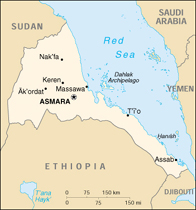|
Why Eritrea? After thirty years of war, Eritrea, a small country in northeast Africa, desires sustainable peace for its people. Eritrea’s best resource are its citizens. However, the nation has a high illiteracy rate caused by an interruption of its educational system during the war, preventing the population from moving quickly into a technological society. A top priority of the government of Eritrea is the education of its people. Government policy makers believe by using current technology tools, Eritrean children can quickly scale the ladder of success. Eritrea does not have the resources to do this alone and is seeking assistance. Craig Johnson, chairman of a new formed group called NetAfrica, led a delegation to Eritrea in 1997 to meet with President Isaias Afwerki. From their discussions, came the seeds of a joint educational project. They discussed how the Internet can assist Eritrea as a training tool to provide teachers and its workforce with Internet access to the rest of the world. In 1998, the Math/Science Nucleus became the umbrella organization for NetAfrica with Teclu Tesfazghi, a Board Member, responsible for outlining a project with the government of Eritrea. In 2002, the Eritrea government selected Ali Suleman to become the national coordinator. Oscar Rosenbloom became the Project Coordinator for the Math/Science Nucleus. Background on Eritrea In 1993 Eritrea established itself as an independent African nation. It has approximately 4 million people in nine different ethnic groups, each speaking their own dialect. Eritrea’s name comes from the Latin word "Erythraem" meaning reddish because of its proximity to the Red Sea. There are approximately 50,000 people of Eritrean origin living in the United States trying to help their former country in various ways. In 1996-97, the Eritrean Minister of Education, Mr. Osman Saleh reported that enrollment in grades 1-12 was 334,997 students with 7,461 teachers in 685 schools and two technical schools. This amounts to a 45 to 1 student to teacher ratio in urban areas, and a much higher ratio in rural areas. After independence in 1991, Eritrea inherited an educational infrastructure that was in need of significant rehabilitation after many years of neglect. Primary school enrollment increased dramatically beginning in 1991 from 150,982 to 295,940 in 2000, and the gross enrollment ratio increased from 36 to 53%. However, the hostilities that ended in 2000 dealt a serious blow to the accomplishments of the last nine years. Thirty percent of the 249 schools in the war-affected areas were either destroyed or damaged. UNICEF provided learning materials to 97,000 of the 205,000 school age displaced children along with the fabrication of 40 makeshift classrooms and an additional 100 tents also set up to serve as classrooms. One of the most compelling challenges for the government of Eritrea is to educate its young so they become productive members of the community. In order for this to occur, the Eritrean government needs assistance in meeting this goal. |
